Think about your most recent online purchase.
What was it that compelled you to click “buy”? Perhaps it was the product photos, a few raving customer testimonials, or maybe it was because of the product description.
Multiple elements factor into a customer’s buying decision, and the product description is no doubt among the most critical. After all, according to a report by the ecommerce platform Salsify, 87% of consumers rate the product description as extremely or very important in their buying decision.
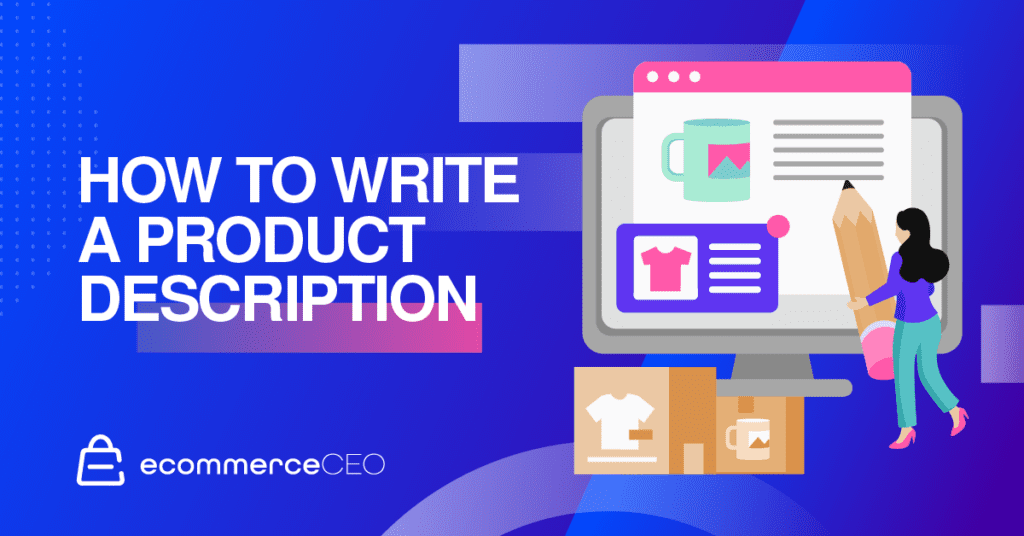
Yet too often, product descriptions don’t provide what potential customers need: the critical details that help buyers make their purchase decisions. As a result, these potential buyers shop elsewhere instead—which can translate into hundreds, even thousands, of lost sales over time.
Fortunately, by understanding the role product descriptions play in your marketing, you can learn how to write a better, more effective description to sway customers.
What is a product description?
As their namesake suggests, product descriptions are the informative snippets of text that explain to users what exactly your product is and does.
It’s thanks to product descriptions that even the most absurd items can gain a following and rack up ecommerce sales—like the ostrich pillow, which raised more than $130,000 on Kickstarter.

Put simply, product descriptions communicate to customers the value of your product. In this way, you can think of them as your 24-hour, 7-days a week sales team. These critical pieces of content educate customers, answer their questions, and convince them that your product is worth spending money on.
Are product descriptions really necessary?
The short answer: yes.
Even before the rise of ecommerce, product descriptions mattered. Consider the item packaging traditionally seen in brick-and-mortar stores—it functions in much the same way product descriptions do by informing customers what a specific product is all about.
Of course, with ecommerce, customers can no longer hold a product, packaged or not, in their hands. Instead, they must rely on product descriptions for information that an image or headline simply can’t convey. Considering that more than 1.8 billion consumers now shop online, that makes product descriptions paramount to your marketing strategy.
9 Tips to Write Product Descriptions That Sell
Overall, effective product descriptions inform users:
- What your product is
- What problems it can solve, or how it benefits consumers
- Why it’s better than your competitors
To get more sales, follow these nine product description writing best practices.
1. Write for your target audience.
Writing an effective product description begins with knowing your ideal customer—in other words, your target audience.
It’s tempting to write descriptions aimed at satisfying everyone, but this approach runs the risk of producing generic copy that appeals to no one.
To write descriptions that speak to your target niche, you need to get to know them. Beyond simple demographic information like age, gender, income, and education, consider:
- What problems does your ideal customer face?
- How is your product relevant to these issues?
- What types of questions would your audience ask about your product? What specific words (vocabulary and slang) would they use?
To illustrate the importance of understanding your target customer, let’s look at two fashion retailers: Chico’s and Hot Topic.
Chico’s clothing appeals specifically to young female professionals. Take a look at one of its product descriptions for an example.

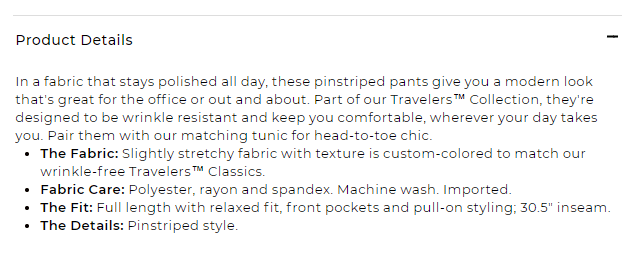
Now, look at the description for a pair of pants sold by Hot Topic, a retailer known for its counterculture-centered products. Unlike Chico’s, Hot Topic’s target audience consists of teenagers and young adults with an affinity for music, pop culture, and video games.
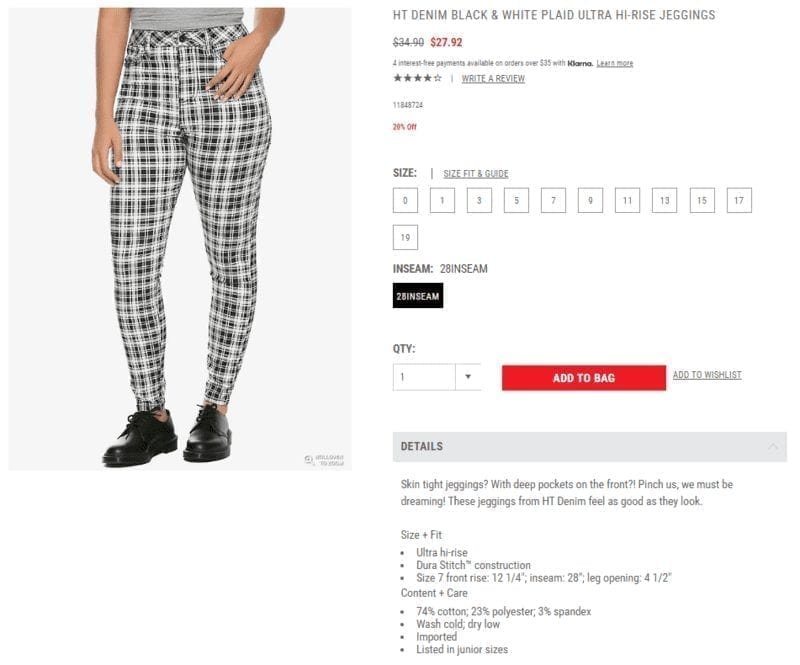
While both product descriptions revolve around pants, it’s obvious that their audiences aren’t one and the same. Can you see how one is tailored to career women while the other aims for teens?
Chico’s description includes phrases like “stays polished all day,” “wrinkle resistant,” and “keep you comfortable”—details that appeal to a working professional’s lifestyle. Hot Topic’s, on the other hand, is far more lighthearted, using effusive wording like: “Pinch us, we must be dreaming!” Its copy also touches on features that appeal more obviously to adolescent fashion tastes, like “skin tight jeggings” and “deep pockets on the front.”
Although both Chico’s and Hot Topic sell apparel, their copywriting differs tremendously. This is no doubt because of their respective audiences, which both brands understand and cater to accordingly to land more sales.
2. Connect your product’s features to the benefits.
Listing all your product’s features can make your potential customer’s eyes glaze over and want to click away from your site. Yes, buyers want information, but they want to see how a product solves their problem.
Your job is to translate a product’s features into benefits. Doing so will help the buyer understand the value of a product, and perhaps even visualize using it themself. Building this connection is particularly important for online businesses since customers can’t physically touch or examine products as they would in a brick-and-mortar store.
For some inspiration, check out Boot Barn’s description of a pair of men’s boots.

The description identifies key product features but on top of this, elaborates on how they benefit buyers. For instance, according to the description:
- The boots are “made with full-grain leather (feature) that is durable and quickly molds to your feet (benefit).”
- They have “high performance lining (feature) [that] keeps your feet dry and comfortable (benefit).”
- They also have a “steel protective toe (feature) that helps keep your feet safe (benefit).”
This is far more effective than merely rattling off features that other competitors’ boots may also have. Instead, by connecting the boots’ features with their benefits, Boot Barn makes the product’s value clearer. This way, buyers won’t just know what the boots are made of; they’ll also understand how the materials and other features impact them directly. Such is the power of connecting a product’s benefits to its features.
3. Use vivid and descriptive sensory words.
When it comes to ecommerce, using vivid language can make all the difference in enticing consumers to buy your product. If you’re not convinced, check out the difference between the two following lines:
- Oversized enough to be worn as a shawl or used as a picnic blanket, this cozy cashmere-like scarf offers stylish flair with its bold colorblock pattern and fluffy fringe.
- A large knit scarf featuring a colorblock design and fringe trim.
Which product would you rather spend your money on?
Chances are the first, thanks to the rich detail offered in its description.
That said, be sure to focus on using words that actually offer info. Avoid vague words like wonderful, exciting, or amazing. Instead, try to create an image. Though product photos help convey how an item looks, they’re not enough—use your product copy to provide supporting details.
Additionally, be careful not to exaggerate your product claims. For instance, if you describe a dress as revolutionary, then you’d better be able to support how it’s revolutionary. If you claim it’s made from the best material, then you’d better explain what makes it superior. If people buy your product and it doesn’t live up to expectations, you can expect disappointed reviews.
4. Craft an engaging story.
There’s a reason why storytelling and content marketing are related. Stories draw your customers in and help them visualize what it would be like to own your product. Not only that, stories help foster an emotional connection between the customer and your brand. This matters because, as research shows, emotions guide consumer behavior.
For product copy, your stories don’t have to be dramatic or long. Perhaps the story illustrates a possible use case. It might even be humorous. Other times, the story can build a scene.
That’s what online furniture retailer Wayfair does in its product description for a fire pit.
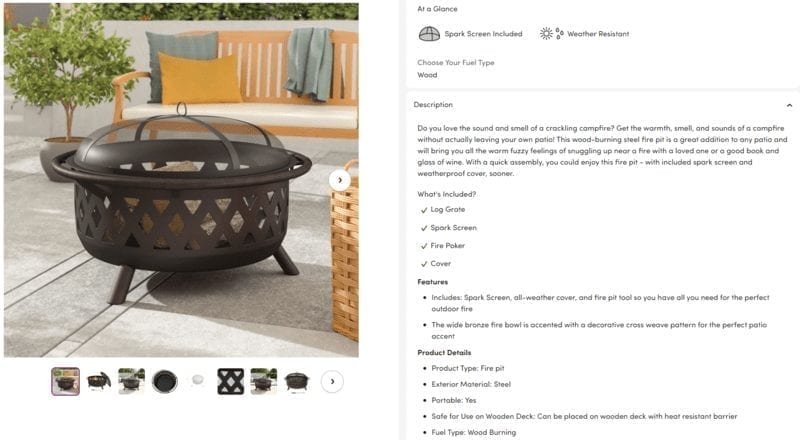
“Do you love the sound and smell of a crackling campfire?” The simple question posed by Wayfair not only invokes users’ senses; it also encourages customers to recall camping memories. And it doesn’t stop there—Wayfair continues: “This wood-burning steel fire pit…will bring you all the warm fuzzy feelings of snuggling up near a fire with a loved one or a good book and glass of wine.”
This wording paints a clear picture for customers, encouraging them to visualize sitting around a campfire or snuggling in the warmth of one. Compare that to an alternate, no-nonsense description: “Wood-burning steel fire pit that is safe to use on wooden decks and assembled quickly.” See how a story feels more compelling and evocative?
5. Be consistent with your brand voice.
An effective product description should reflect your brand’s tone and personality. Copy that goes against it can be confusing to potential buyers; in some cases, it may even be off-putting.
In one of our earlier examples, Chico’s product description clearly reflects a more modern, mature tone, while Hot Topic’s playful product copy embodies its youthful brand. Had the two retailers reversed their approaches, their descriptions would have come across as jarring and unnatural. To avoid any incongruity for your own products, keep your overarching brand voice in mind as you write your product descriptions.
Of course, for those looking to grab and hold consumers’ attention, you may be wondering: Where does humor fit into this?
When done well, humor adds a memorable touch that boosts sales. Indeed, 53% of customers report being able to remember advertisements more if they’re funny. However, humor should only be incorporated if it fits with your brand’s personality—don’t force it if it’s unnatural.
Here’s a fun example from Old Spice that both educates readers and elicits laughter.
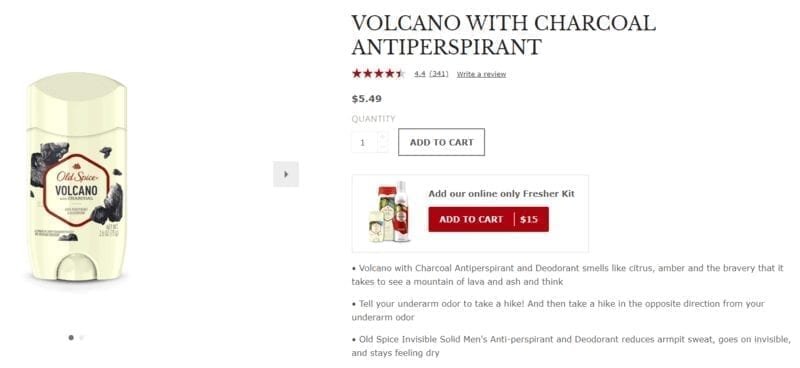
Now compare it to the product description for one of Dove’s deodorants.
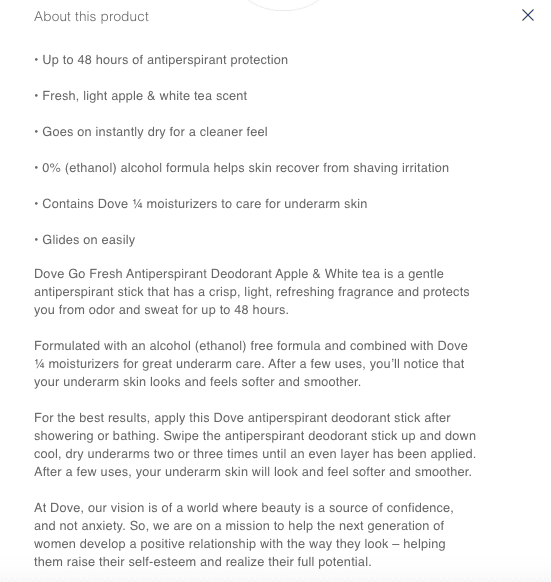
There’s a clear difference between how each brand presents its own antiperspirant—and it’s not fair to say that one works better than the other. Instead, both Old Spice and Dove succeed in sticking to their respective brand voices. Old Spice maintains the levity of its famous Old Spice Man commercials while Dove continues the same tone as its Real Beauty campaign. Had Dove attempted to be funny for the sake of improving sales, it would have come across as insincere and possibly undermine its larger branding campaigns.
6. Make your descriptions scannable.
According to the Nielsen Norman Group, people tend to scan text when reading online. Applied to ecommerce, this means large blocks of text actually discourage customers from reading about your product.
To make your copy more readable:
- Incorporate bullet points.
- Bold or italicize key phrases.
- Create eye-catching headlines and subheadlines.
- Choose a font face and size that’s easy to read.
But beyond simply formatting your product description’s text for scannability, you should make it a priority in your site’s design. For instance, check out how Oculus lays out its product pages.
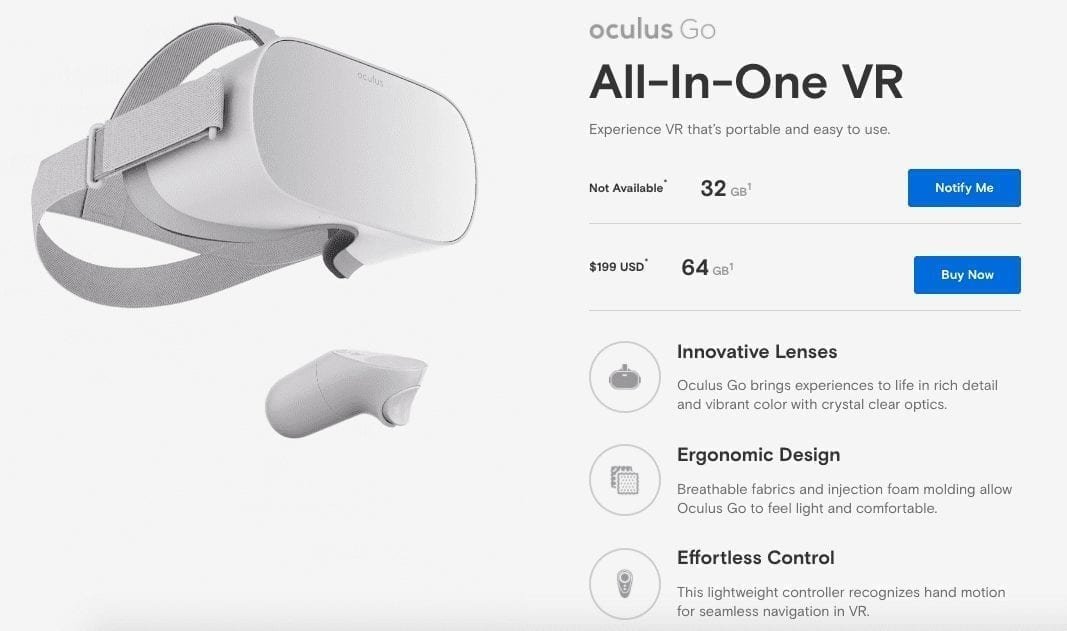
Information about Oculus’s all-in-one virtual reality headset is easy to read thanks to:
- Bold subheadings announcing the headset’s name and main features
- Visual icons paired with each feature
- Different font sizes that highlight the importance of various pieces of information
7. Provide social proof or credibility statements.
Oftentimes consumers, especially those new to a brand, look for guidance on what product to buy by reading reviews. In fact, 93% of customers say reviews affect their purchase decisions.
To take advantage of this tendency, add social proof and credibility statements to your product descriptions. This could be by:
- Labeling products that are best sellers or “most popular”
- Providing quotes from customers
- Including an “As Featured In” statement, if applicable
- Adding endorsement statements
Nowadays, many brands include a rating bar on their product pages—a quick and simple visual that acts as social proof. For an example, check out the chocolatier company Godiva.
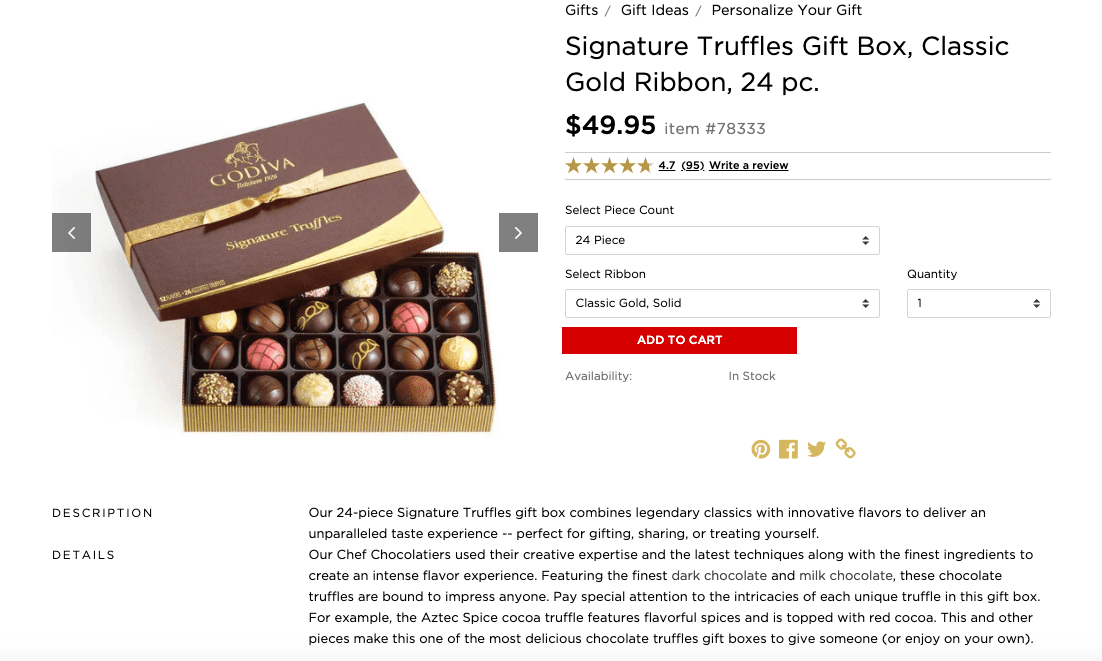
Scroll further down, and you’ll even see customer reviews.
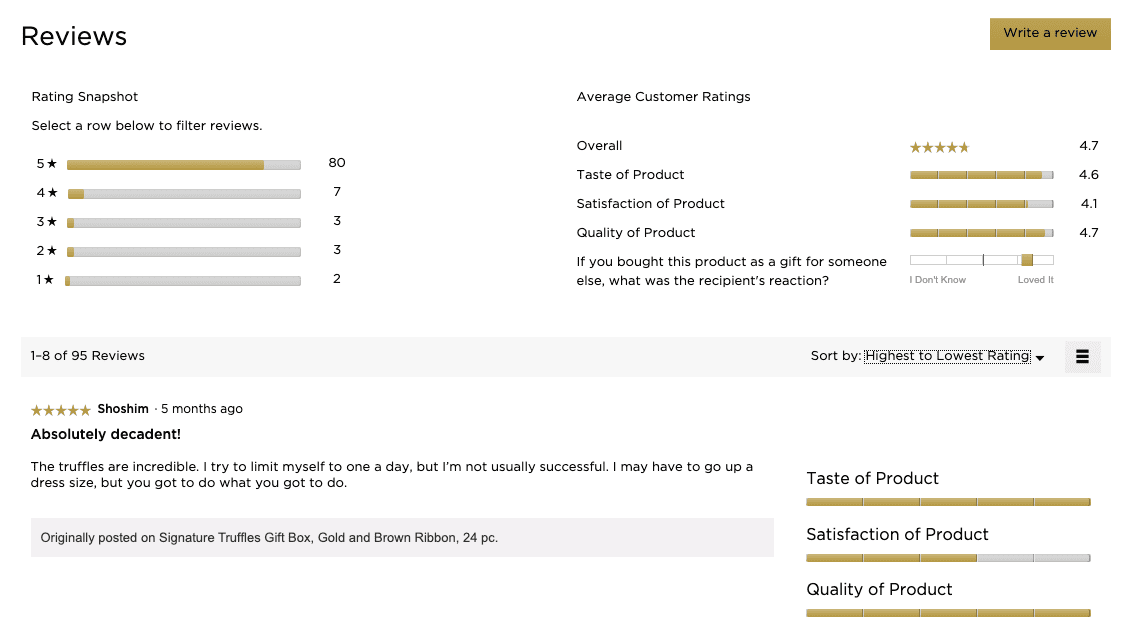
Combined with a well-written product description, glowing customer testimonials can help validate your product.
If you don’t have ratings or reviews yet (or the plugins to support them), don’t lose hope.
Unlike its competitor Godiva, Lindt takes a simpler approach by touting the popularity of its truffles in its product description. Words and phrases like “beloved” and “always a crowd pleaser” help emphasize that its milk chocolate truffles are among the chocolatier’s most popular, no matter the occasion.

8. Insert relevant keywords for better optimization.
Optimization for search is a must for ecommerce businesses—without it, how would customers even find your product?
To optimize your copy for search engines, identify keywords that are relevant to your product. Be specific. For instance, if you sell handmade soaps, include the key ingredients in your keyword, such as handmade goat’s milk soap.
Place these keywords strategically in your product page so that search engines can better understand what exactly you’re selling. That means including the keyword in the following spots:
- The body of the product description
- Meta descriptions
- Alt tags
- Page titles
There’s a wealth of online tools that can help you find product keywords with a high search volume—even tools designed for a specific ecommerce platform like Amazon. If you’re short on financial resources, you’ve still got plenty of free options, including Google itself.
Simply search for your product using its most basic term, and scroll down to the bottom of the search results page. There, Google offers related searches—and the fact it suggests these indicates that these queries are common among users.
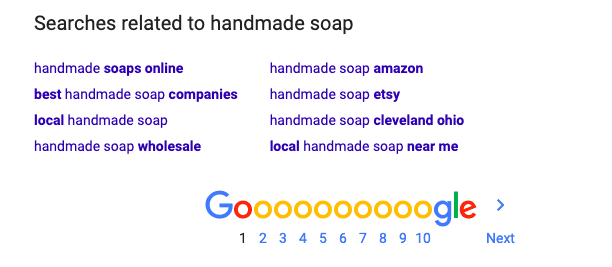
Besides using Google’s actual search engine, you can also use its data-rich companion resource, Google Trends.
Google Trends is essentially a consolidated library of Google’s search data—meaning it’s chock full of insight on keywords users are searching for. Just enter in your main keyword, and you can see:
- How searches for it have fluctuated over time
- Where the most searches take place
- Related topics and queries
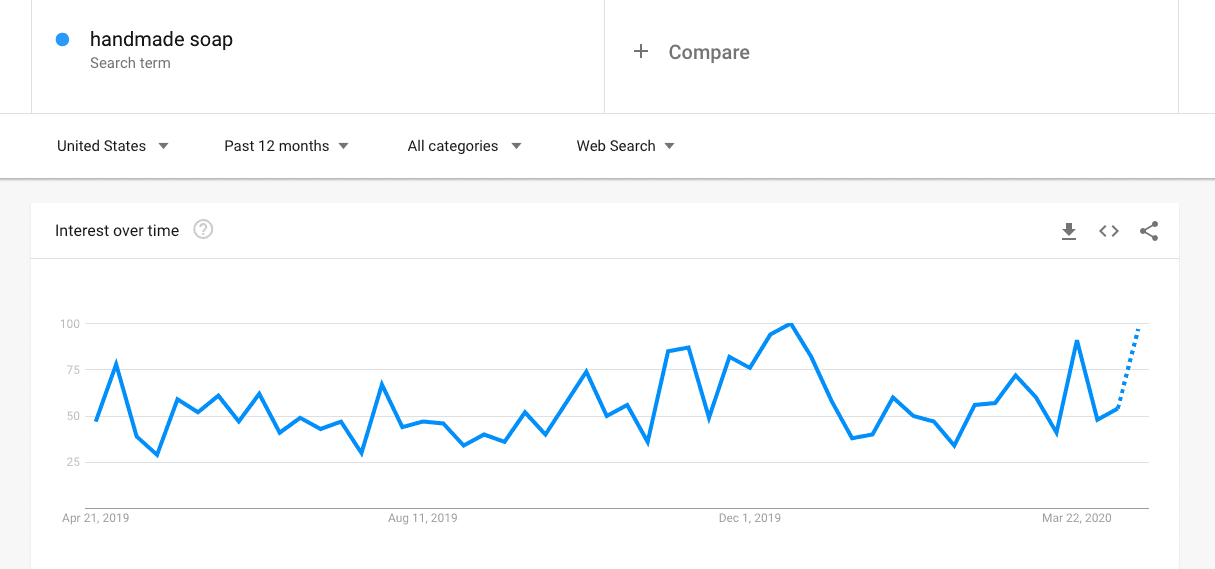
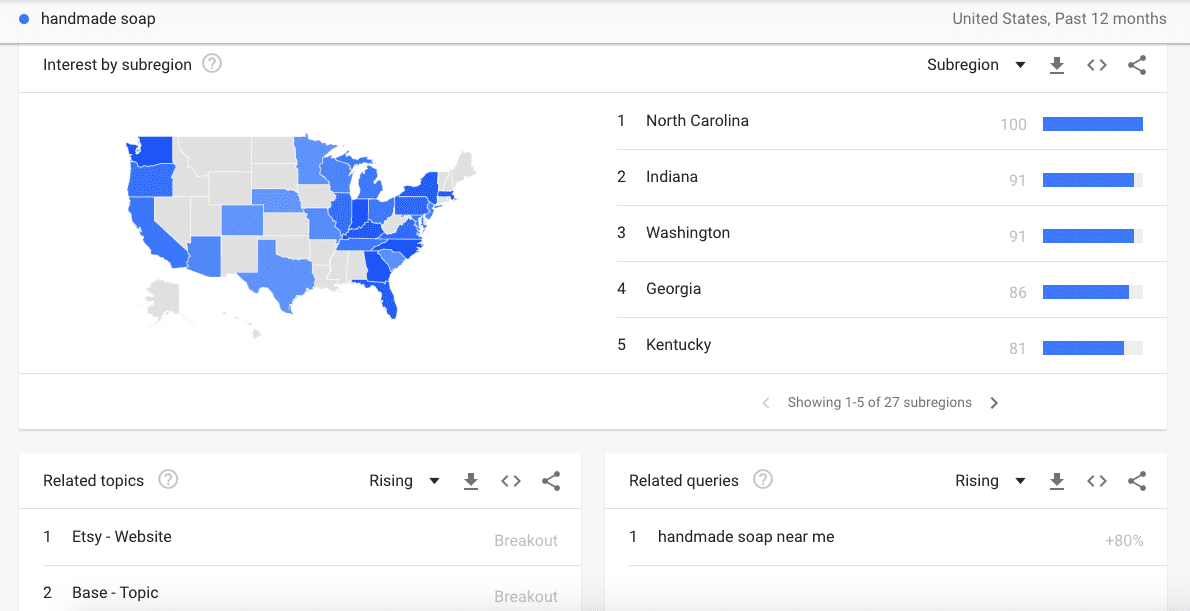
Of course, while keyword optimization is essential, it’s also critical to write your product descriptions naturally. You should never stuff keywords meaninglessly into your copy to rank highly in search results. This strategy backfires since it looks spammy—to both search engines and users.
9. Use complementary images and mixed media.
Sure, including images isn’t quite the same as writing masterful product copy—but it’s nonetheless crucial. The right visuals bolster the effectiveness of your product descriptions.
In fact, research indicates that after landing on a product page, 56% of users immediately explore product images, looking for details like an item’s size. As a result, it’s critical to use quality images that catch the consumer’s attention and visually inform them about your product. Be sure to also look for visuals that attract or complement your copy.
For instance, Subaru’s vehicle product description incorporates a variety of pictures throughout its text to show its automobile features in action. The picturesque photo backgrounds evoke a sense of adventure, establishing a positive association between Subaru’s cars and fun travel possibilities.

Perhaps your product isn’t particularly eye-catching. If so, you can style your product images to take an infographic-like approach. For an idea of how this might look, check out home goods retailer StarPack. It highlights elements of one of its product descriptions by including them on the product image itself, along with corresponding icons.
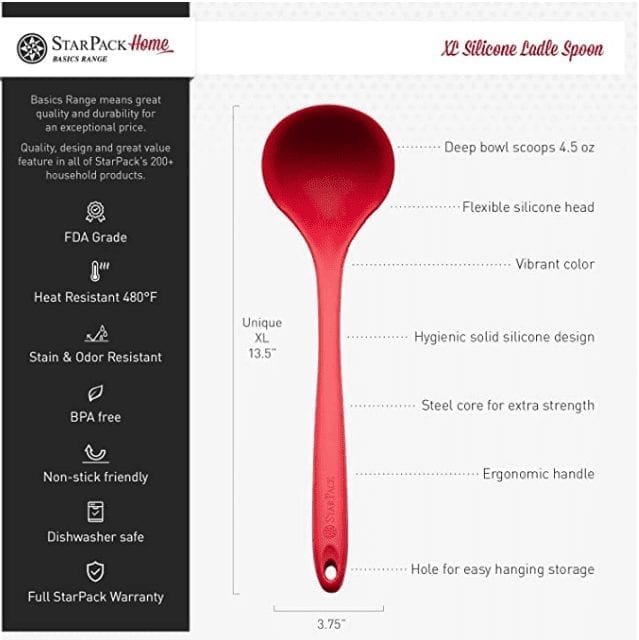
(Image credit: StarPack on Amazon)
Depending on your product, you could also use diagrams or videos, which are especially helpful if what you’re selling requires some explanation. That said, only use the types of media that make sense for your product. There’s no need to create a diagram for a t-shirt, for instance—but it might be helpful for shoe insoles that offer arch support, like Dr. Scholl’s products.
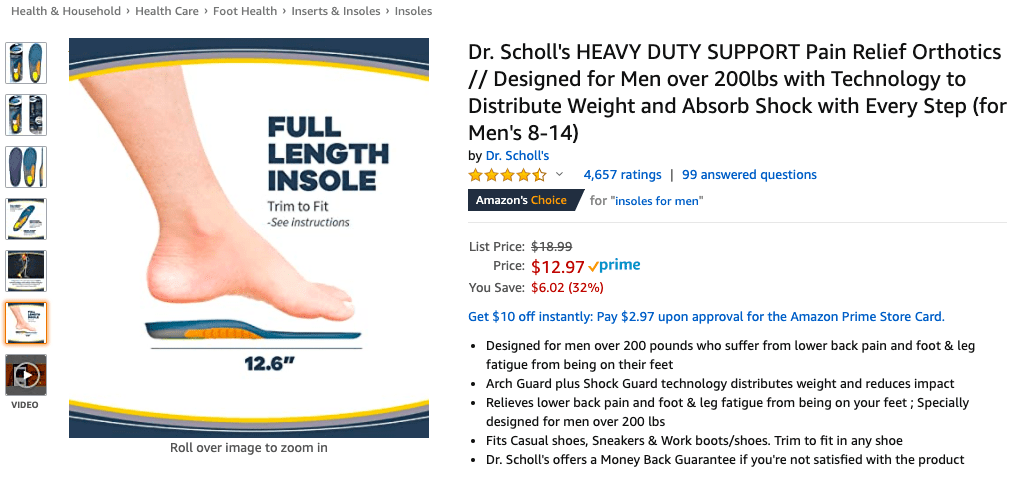
Free Product Description Template
It can be difficult to put all the tips above into practice, especially if writing isn’t your forte. To get your creative juices flowing, try this foolproof product description template.
- Tagline: Think of this as the slogan for an individual product. It’s a simple phrase or short sentence that grabs a shopper’s attention without getting into the weeds.
- Taster: Provide a high-level overview of your product, one that succinctly sums up the answer to the question, “Why should anyone care about this product?” This section is generally 1-2 paragraphs, but if you choose to write more, be sure to include line breaks so that it doesn’t overwhelm buyers.
- Specifications: Here’s where you’ll answer “How does this product work?” Make this section easy to read by formatting it as a bullet point list. Aim for a minimum of 4 points—think details like the material your product is made of, its size, and other distinguishing features worth highlighting.
This three-part template is used across all kinds of ecommerce businesses because it works. Just take a look at these real-life examples of product descriptions that use this formula:
Birdy Grey
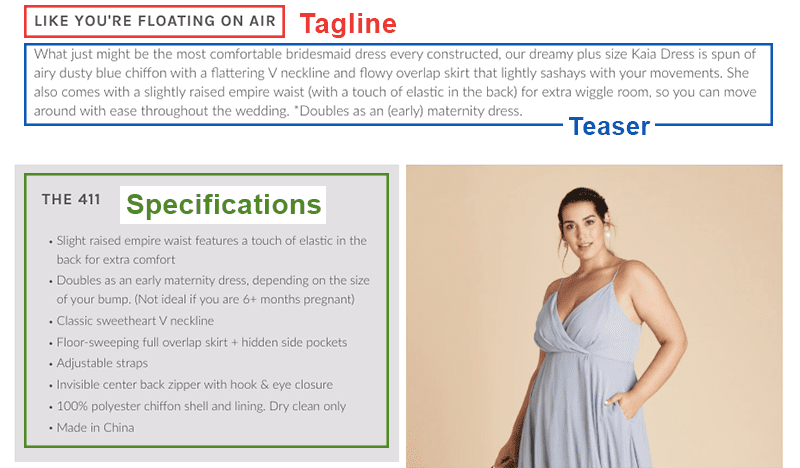
Morton Salt

Sand Cloud

As you can see with the above examples, the exact formatting of your product description will vary based on your website design. Regardless, this template is a surefire place to start for writing compelling descriptions that boost your brand’s conversion rate.
Knowing How to Write a Product Description = More Conversions
When it comes to writing product descriptions, there isn’t one magic formula or template that works for all products. You’ll need to adjust accordingly based on your audience and whatever you’re selling.
What’s more, writing a compelling product description takes some trial and error. If you find an item that’s lagging behind in sales, consider experimenting with its copy and layout. For instance, expand on its benefits, include use cases, or reverse the position of the text and image. Make a note of how these changes affect sales—and then apply these findings to other product descriptions.
Over time, you’ll find what works best for your brand, so long as you continue refining your copy to better resonate with your audience.









